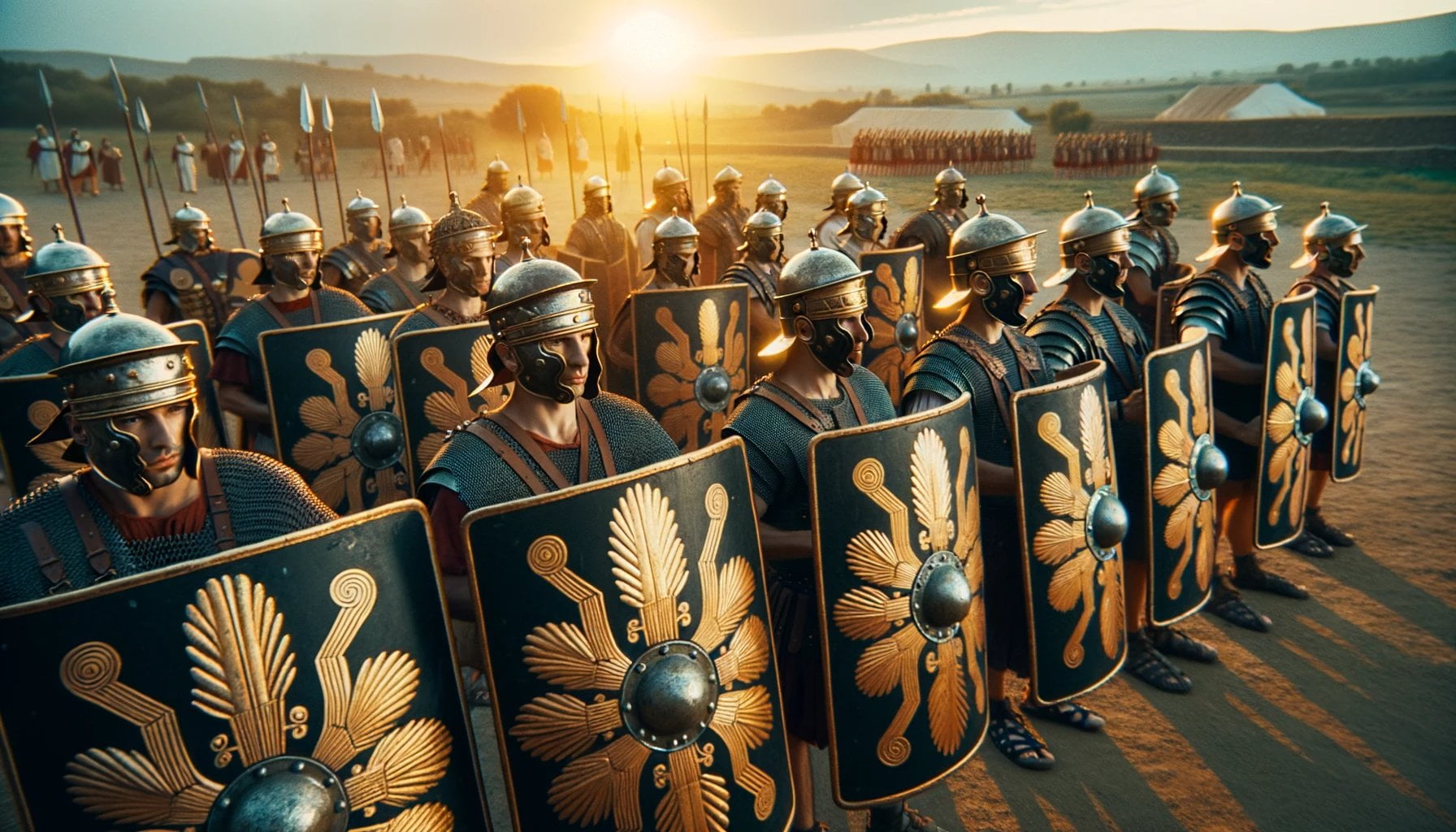Step into the arena of ancient Rome and discover the secrets behind the shields that defended the mighty Roman Empire. These shields were more than just protection; they were symbols of Roman power and skill. From their humble beginnings as basic wooden planks to their elaborate, metal-covered designs, these shields evolved alongside the legions they protected, playing a crucial role in both offense and defense. Embark on a journey through the centuries, uncovering the intricate craftmanship and strategic significance of these iconic shields.

Ancient Roman Shields: The Unsung Heroes of Military Might
Imagine yourself as a Roman legionary, standing shoulder-to-shoulder with your comrades, locked in battle. Your shield is your trusty companion, guarding you from harm as you march towards victory.
The ancient Romans didn’t just build shields—they crafted works of art that empowered their soldiers and shaped the course of history. Let’s delve into the fascinating world of these iconic protectors.
Evolution of Roman Shields
The Romans were always on the lookout for ways to improve. Their shields evolved over time, from the round “clipeus” to the rectangular “scutum.” The scutum became the mainstay of the Roman army, providing superior protection from head to toe.
The Art of Shieldmaking
Roman shields were more than just blocks of wood. They were carefully crafted using multiple layers of wood, glued together and covered with canvas and calf-skin. Red paint and decorative motifs added a touch of flair, showcasing the legions’ pride and discipline.
Types of Roman Shields
The Romans had shields for every occasion:
- Scutum: The most common type, a large, rectangular shield that covered the entire body.
- Clipeus: An older, circular shield used by auxiliary troops.
- Parma: A small, round shield for cavalry and skirmishers.
The Shield as a Weapon
Roman shields weren’t just shields—they were also offensive weapons. Legionaries would use their shields to bash their opponents, create space, and form impenetrable formations. The “testudo” (tortoise) formation was particularly effective, allowing the Romans to advance under enemy fire.
A Legacy That Lives On
The ancient Roman shield continues to inspire shield designs even today. From medieval knights to modern soldiers, the principles behind Roman shieldmaking have been used to protect warriors throughout history. These shields stand as a testament to the ingenuity, discipline, and unwavering spirit of the Roman Empire.
Interesting Fact:
Did you know that Roman shields were often given nicknames? Some common ones included “Scutum Aquila” (Eagle Shield) and “Scutum Hercules” (Hercules Shield).
Check out our collection of ancient Roman monuments, including famous sites like the Colosseum and the Pantheon. To explore these architectural wonders, click here: ancient roman monuments
Step back in time and marvel at the impressive ancient Roman pillars. These magnificent structures are a testament to the engineering prowess of the Romans. For a closer look at these architectural marvels, click here: ancient roman pillars
Experience the grandeur of ancient Rome with our collection of gladiator armor. Discover the intricate details and craftsmanship that went into creating these iconic pieces. To see our collection, click here: ancient roman gladiator armor
Delve into the world of ancient Roman philosophy, where great thinkers like Seneca and Marcus Aurelius shaped the course of history. Explore their teachings and ideas by clicking here: ancient roman philosophy
Roman Shields: Their Evolution and What Purpose Did They Serve?
Origins and Evolution
Ever wondered where Roman shields came from? In the early days, they used little round shields called “clipeus.” But as they got better at fighting, they switched to the rectangular “scutum.” This new shield was bigger, curved, and gave them more protection and freedom to move around.
Construction and Materials
Roman shields were built tough, with layers of wood, canvas, and animal hide. They were so sturdy that they could deflect blows and arrows like nobody’s business. The curved shape helped make them even stronger.
Symbolism and Decoration
These shields weren’t just for protection. They were like giant billboards for the Roman army. They were often painted with fancy designs and symbols that showed off their triumphs, their gods, and their pride in being Roman soldiers.
Offensive and Defensive Use
Roman shields were more than just defensive tools. They could also be used to bash enemies or knock them off their feet. And when they formed a wall of shields called a “testudo,” they were almost impossible to break through.
Key Takeaways:
- Roman shields evolved from a round shape to a rectangular shape, providing better protection and mobility.
- They were made of tough materials like wood, canvas, and animal hide.
- Roman shields were decorated with symbols that represented their identity and victories.
- They could be used for both defense and offense, making them versatile weapons on the battlefield.
What materials and techniques did the Romans use to build their iconic shields?
You can’t picture ancient Roman legions without their famous shields. They were more than just protection; they were a symbol of Roman power and discipline. But what exactly were they made of, and how did they make them so strong and protective?
Let’s take a closer look at these legendary shields and learn about their materials and construction techniques:
Materials
Wood: The Romans used lightweight but sturdy wood for the main part of their shields. They often glued thin layers of wood together to make plywood for added strength.
Canvas: On top of the wood, they put layers of canvas. Canvas is a strong and flexible material that made a great base for the shield’s surface.
Calfskin: The final layer was calfskin. They stretched it tightly and glued it over the canvas. This gave the shield a waterproof and smooth finish that could protect it from cuts and punctures.
Construction Techniques
Curved design: Roman shields weren’t flat; they had a curve to them. This curve helped deflect blows and protected the soldier’s body better.
Multiple layers: Wood, canvas, and calfskin worked together to make shields extremely durable. Each layer absorbed and spread out the force of blows, making it hard to break through.
Metal reinforcements: To protect against sword strikes and other sharp weapons, they added metal studs or bands to the edges and center of the shield.
Handle and grip: A wooden handle was attached to the back for a comfortable and secure grip.
Paint and decorations: Roman shields were often painted red and decorated with different designs. These designs could include legionary symbols, mythological figures, or personal markings. This added a bit of style and helped different units recognize each other on the battlefield.
Key Points:
- The main materials used were wood, canvas, and calfskin.
- Shields were curved to better deflect blows.
- Layers of materials provided high durability.
- Metal reinforcements strengthened the edges and center.
- Sturdy handles made it easy for soldiers to hold the shields.
- They were often painted and decorated with various designs.
So, there you have it. Roman shields were masterfully crafted using these materials and techniques. They were a symbol of discipline and power on the battlefield, and they played a vital role in the success of the Roman legions.
How Did the Design and Shape of Ancient Roman Shields Evolve Over Time?
Ever wondered how the iconic shields of ancient Roman soldiers came to be? It’s a fascinating journey that reflects the evolution of their military might.
In the early days, Roman shields were simple ovals or circles, offering basic protection but hindering their movement in battle. As their legions expanded, the need for a more formidable shield became apparent.
The Game-Changing Scutum
Enter the scutum, the shield that became synonymous with Roman soldiers. This curved and semi-cylindrical masterpiece provided the perfect balance of defense and agility. Its shape allowed them to block enemy blows from all sides while still being able to wield their swords and charge forward.
Variety Is the Spice of Life
Roman shields weren’t one-size-fits-all. They came in different shapes and sizes to suit the needs of various soldiers. Auxiliary troops, for example, carried smaller rectangular shields to enhance their mobility in rugged terrain.
Evolution in Action
The scutum didn’t just appear out of thin air. It evolved over time, with minor design changes enhancing its effectiveness. The addition of a central ridge, the umbo, provided extra reinforcement against piercing strikes.
The Shield as a Symbol
The Roman shield was more than just a piece of armor; it represented the legions’ power and discipline. It was a symbol of Roman civilization, respected and feared by enemies throughout the empire.
Timeline of Roman Shield Evolution:
| Period | Shield Type | Characteristics |
|---|---|---|
| Early Republic | Oval or circular | Basic protection, limited maneuverability |
| Late Republic | Scutum | Curved, semi-cylindrical, maximum defense and maneuverability |
| Imperial Period | Rectangular | Used by auxiliary troops for increased mobility |
| Late Empire | Scutum with added umbo | Enhanced piercing resistance |

FAQ
Q1: What was the most common type of shield used by Roman legionaries?
A1: The scutum was the most prevalent shield used by Roman legionaries throughout the empire’s history. Its distinctive rectangular shape and curved design provided optimal defense and maneuverability, making it a crucial component of the legionary’s装備.
Q2: How did the design of Roman shields evolve over time?
A2: Roman shields underwent significant evolution, initially influenced by Greek hoplon shields. Over time, the circular clipeus was replaced by the curved, semi-cylindrical scutum, which offered superior protection and versatility in close combat formations.
Q3: What materials were Roman shields made of?
A3: Roman shields were primarily constructed using a combination of wood and leather. The wooden foundation, often made from sturdy planks, provided the shield’s structural integrity, while layers of leather or canvas were affixed to enhance durability and impact resistance.
Q4: What was the symbolic significance of Roman shields?
A4: Roman shields were not merely defensive tools; they also held symbolic value. Decorations and emblems emblazoned on shields represented Roman identity, military achievements, and religious beliefs. Lightning bolts and laurel wreaths were common motifs, signifying power, victory, and divine protection.
Q5: How did Roman shields contribute to the success of the Roman Empire?
A5: Roman shields played a pivotal role in the military prowess of the Roman Empire. Their robust construction and ergonomic design allowed legionaries to form cohesive formations, known as the testudo or tortoise formation, effectively repelling enemy attacks and maintaining battlefield advantage. The shields’ impenetrable wall-like structure enabled Roman soldiers to advance relentlessly, contributing to the empire’s military dominance.
- Unlocking 2-Letter Words with U: The Definitive Guide - April 4, 2025
- Unlock Words with the Letters THREE: Top Unscramble Tools 2025 - April 4, 2025
- Master Scrabble: X & Z Words for High Scores - April 4, 2025
















